- Home
- Encyclopedia
- Hard Times and Conservation: The CCC In Wyoming
Hard Times and Conservation: the CCC in Wyoming
Red Fenwick couldn't believe what he saw in 1933 when he met the train that carried a motley group of Bronx youth to Canyon Junction in Yellowstone National Park.
"It was the sorriest assemblage of humans since Indian treaty days," recalled Fenwick, a foreman assigned to whip into shape the first Civilian Conservation Corps crew assigned to work in the park.
Fenwick, who later became a well-known Denver Post reporter, wrote in a 1965 column that some enrollees were already homesick, while others were clearly out of control.
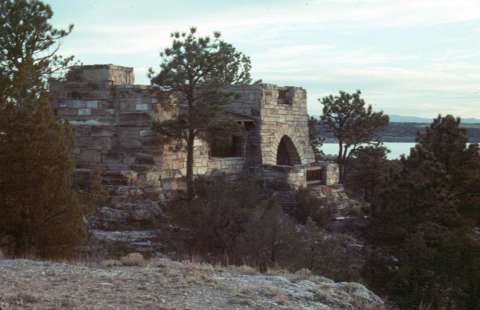
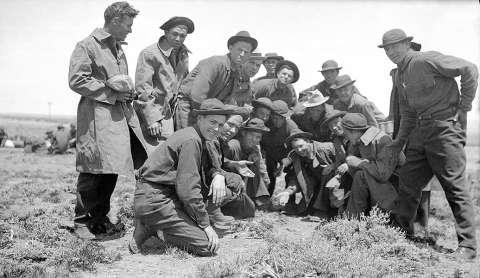
"All needed a shower and shave," he remembered. "They looked as though they had walked past an army surplus supply depot after an explosion and had grabbed whatever items of clothing they fancied."
The young men took a truck to their camp where one of Yellowstone's many geysers greeted them, sending an impressive column of steam and hot water high into the sky. Fenwick remembered one young rider who excitedly told his companions, “‘Hey youse guys! Lookit dat t'ing squoiting outa d'ground. It's a geezer! Dat's wot it is--a'geezer.’"
Roosevelt’s Tree Army
Throughout Wyoming and across America, thousands of young men were also getting acquainted with their new environments. It was part of President Franklin D. Roosevelt's plan during the Great Depression to provide jobs and educations for millions of unemployed youths while conserving the nation's natural resources.
The CCC went from an idea to reality in lightning speed, especially compared to modern-day federal programs. A month after his proposal to Congress, Roosevelt signed the law officially creating the Emergency Conservation Work (ECW) project on March 30, 1933. It quickly became known as the Civilian Conservation Corps, and also had a popular nickname—the "Tree Army."
By June 1,300 CCC camps had been created nationwide, and by the next month they were staffed by a total of more than a quarter-million enrollees. Initially there were 24 camps in Wyoming, each expected to house 200 men.
To join, enrollees had to be 18 to 25 years old, unmarried, unemployed and with a family on relief. The pay was low, even for the Depression. The CCC paid the enrollees $1 a day, so each earned about $30 each month. But $25 was taken from their checks and sent to their families, leaving them only $5.
"None of the men are going to do any work like that for a dollar a day," predicted Maurice Miller of Chicago, a group leader at the CCC encampment at Fort Hunt, Va.
Joseph Bosc, a Chicago clerk, said he definitely wouldn't enroll. "[It's] not for me; it's like being sold into slavery," he said.
Most of the new members of the Corps, though, didn't look at it that way. Jobs and money were scarce, and signing up was a way to help their families. Their room and board would be paid for, and they would be sent to areas of the country most had never seen before.
Not all were such willing participants, however. Precinct police captains in New York City gave some young men a choice: Sign up or go to the reformatory.
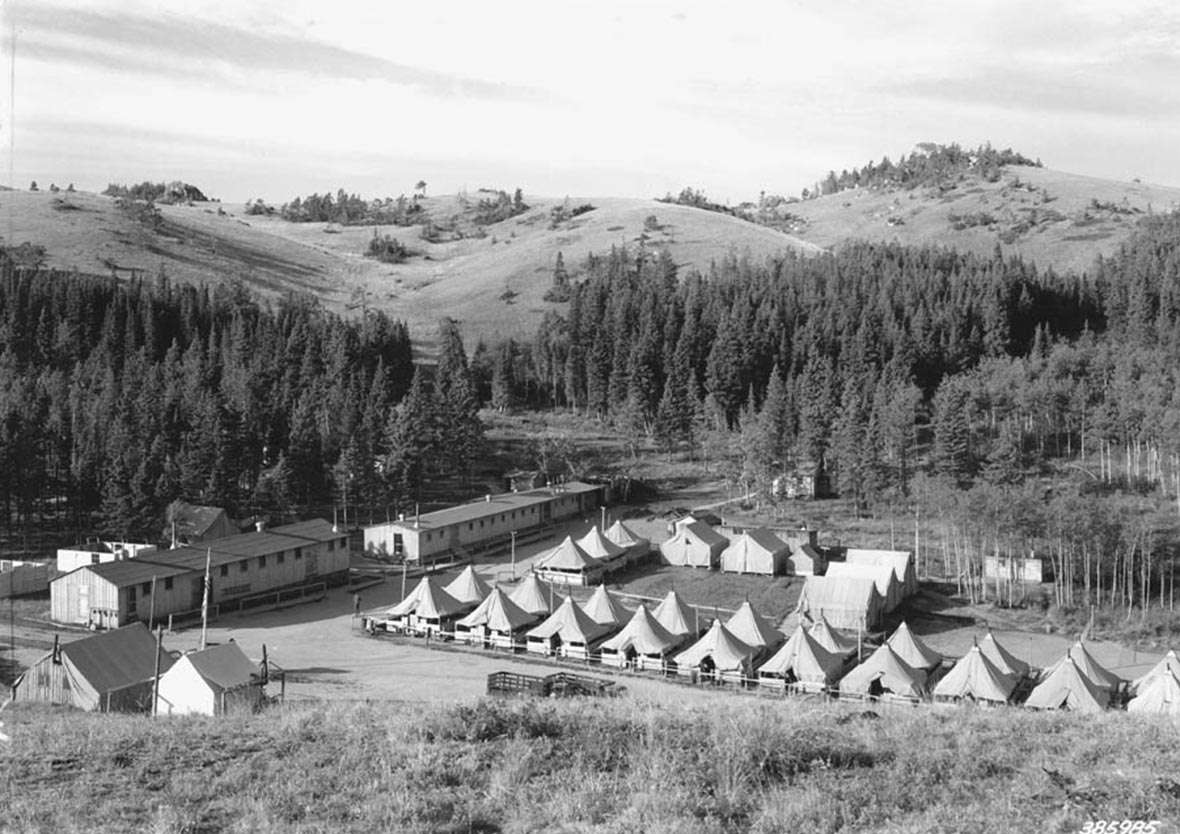
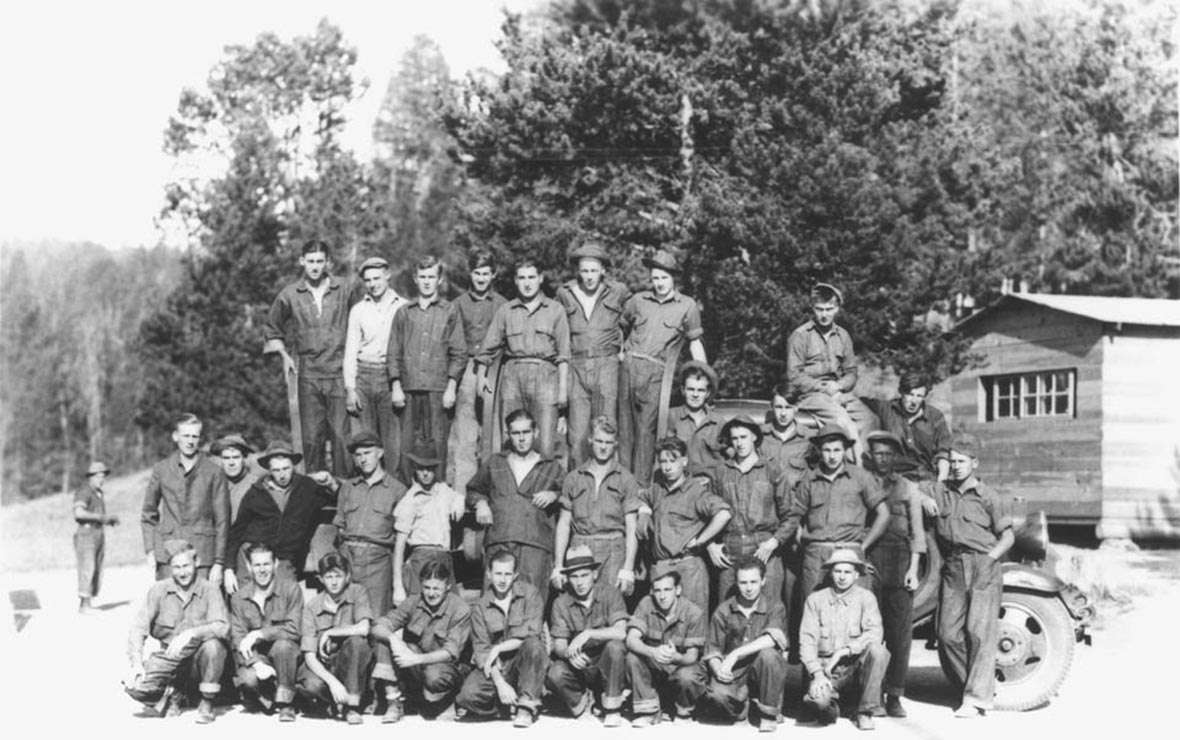
Creation of the CCC
More than 1,000 young men served in the state between 1934 and 1938. During this period age restrictions were lifted so more veterans of World War I could find work, and so was the requirement that enrollees had to be unmarried.
They constructed sewer and water systems, service roads, museums and exhibits, boat docks, phone lines, utility buildings and snowshoe cabins for patrols. They eradicated gophers, eliminated locoweed and dug garbage pits.
Major projects in Wyoming's national forests involved protecting the Colorado and Missouri River watersheds, developing recreation facilities and thinning forests. The CCC launched several wildlife protection projects, including preservation of the country's largest elk herds. The young men also transplanted beaver from overstocked areas to more favorable sites. Crews took censuses of wildlife and studied game ranges, migratory patterns and feeding habits. In several forest areas, especially in the Medicine Bow National Forest, bark beetle control was a constant battle. Blizzard relief was undertaken during the harsh winter of 1936-37.
And the men were always on call to fight forest fires, which could quickly turn deadly. Nine members of various CCC companies in the area died fighting the Blackwater Creek fire west of Cody in 1937. Five professional firefighters from the Forest Service who were supervising the work crews also perished in the blaze.
One of the most challenging CCC projects in the state was undertaken by a Gillette crew, which fought the fires burning more or less constantly in some exposed coal seams and abandoned mines. At least 17 coal fires were burning in Campbell County, many started by lightning decades before.
Some of the fires were about 1,000 feet in length along the outcrop. The CCC enrollees would either dig out the burning material and then cover the remaining exposed coal with sand or extinguish the fire by sealing it and depriving it of oxygen. By all accounts the effort was impressive—but also slow going.
Jackson Lake saw one of the largest projects undertaken by the CCC in Wyoming. A dam built by the U.S. Reclamation Service in 1916 enlarged the lake, and as it filled it flooded more land and submerged more than 8,000 acres of timber.
The stretches of dead timber around Jackson Lake created a barren and dangerous setting, and the Hoover administration began the cleanup in 1929. Roosevelt had the CCC take over the job in 1933.
“Over 100 young men spent the summer of 1934 cutting and piling some 17,000 cords of wood to be burned during the winter months," noted Historian Robert Righter. By the mid-1930s the CCC had removed the shoreline tragedy at Jackson Lake.
CCC members could serve up to four six-month hitches. Despite the demanding work, more than half re-upped at least once.
Many enrolled in camp educational programs. Camp Miller in Sublette County offered vocational courses like blacksmithing, bulldozer operation, carpentry, woodworking, cooking, vocational guidance, road construction, tractor operation and photography. Academic courses included English composition, spelling, business arithmetic, trigonometry, Latin, Spanish and citizenship.
Enrollees were also given the opportunity to take correspondence studies with the University of Wyoming, including English, mathematics, social science, biology, typing and shorthand. The University also offered special courses for CCC recruits in auto mechanics, forestry, journalism and bookkeeping.
Towns lobbied for Camps
By August 1933, 24 camps were already established in Wyoming. Seven camps were attached to the National Park Service— four in Yellowstone and three in Grand Teton. Fifteen camps were supervised by the Forest Service, including seven in Medicine Bow National Forest—at Pole Mountain, Chimney Park, Centennial, Arlington, Encampment, French Creek, and Ryan Park. There was also at least one in the Bighorn National Forest—Camp O’Connor near the subsequent Muddy Guard Station in the Buffalo Ranger District.
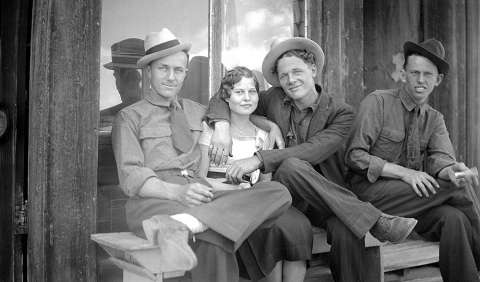
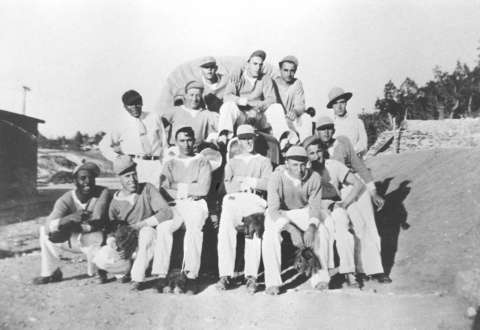
Because of the lack of a complete Forest Service CCC inventory, the location of seven camps during the initial year are unknown. One camp may have also been located on the Wind River Indian Reservation, still then called the Shoshone Agency, before 1937. The final Wyoming camp, GLO-1, was operated by the U.S. General Land Office, a precursor of today’s Bureau of Land Management, and located on private land near Gillette.
The number of CCC camps in Wyoming likely peaked at 32 in 1935; that number dropped to 15 camps within two years. Wyoming towns wanted more camps, not fewer, because the program provided jobs for unemployed local carpenters and other workers hired for the skilled labor required by many CCC projects. Communities located near camps also benefited economically when CCC members made weekly excursions into town. Locals lobbied their congressional representatives and the ECW director for more enrollees and more camps.
But even worthy projects promoted by commercial, business, agricultural and civic leaders were turned down. Citizens of Bridger Valley in southwestern Wyoming spent the first two years of the CCC program trying to get a camp on the Bear River in Uinta County. They needed dams built on the Green River's Black’s Fork or Smith's Fork to control flooding for approximately 200 family ranches. If the reservoirs could not be constructed, the leaders said, families would not be able to continue making a living in Bridger Valley.
The lobbying effort was led by an impressive group of officials: Fort Bridger American Legion Commander H. M. Hopkinson, Black’s Fork Water Users Association President Joseph Micheli, Uinta County Farm Bureau President Starvold Steward, Evanston Chamber of Commerce President Glen Eastman, and Van Rupe, president of the Lyman Lions Club.
Desperate for help, the coalition noted if they could not secure a camp in Uinta County, they would "settle" for one across the state line in Utah. By 1935, though, the CCC was starting to close camps, not add them. As Roosevelt's Second New Deal began, the president ordered that camps still working on their original projects be continued, but funding was not available for new ones.
Primitive conditions
In the early days of the CCC, living conditions were primitive. The men slept in cheaply made tents until they built their own camps, with the work usually supervised by out-of-work miners and carpenters from the nearest town. This immediately established good relationships between the CCC and local residents who saw a boost in their economy from both construction and visits from the men to their towns on weekends.
The first wave of CCC enrollees were given hand-me-down U.S. Army surplus uniforms and equipment from World War I. Later, they were outfitted in new spruce green uniforms.
Fenwick said the cooks at his first Yellowstone camp regularly burned food and served cold-boiled potatoes that were hated by all of the hard-working, hungry diners. "The men had plotted to stand at signal at dinner and throw the potatoes at the mess officer," Fenwick recalled. The commanding officer, a holstered .45-caliber service revolver on his hip, told them he knew about their plan.
"I warn you that I've taken just about all I can stand from you," he said. "The first man that throws a potato in that mess hall tonight will get a bullet right between his eyes. I can put it there."
The commander stood at the mess hall door throughout the entire meal. Fenwick wasn't surprised that no potato protest materialized.
CCC members had to stretch their scarce dollars. They paid for personal items like toothpaste, tobacco products, hair oil, candy and gum, which they bought at the camp's post exchange. The men bought $2 vouchers, and the money was deducted from their pay.
To make extra money, some used their pre-CCC experience or learned new skills like cooking and took jobs in nearby communities during their off hours. Leo Vaughn, who worked at a camp in Thermopolis, knew how to sew and boosted his income by sewing on buttons and mending clothes.
Leo Kimmett, who was stationed at a CCC camp in Yellowstone, asked to borrow a typewriter from the company clerk so he could address a letter. A clerk's six-month hitch in the CCC was nearly over and the camp needed someone who could type and take over his duties. Kimmett was the only one in camp who could type, so he was the obvious replacement. He didn't mind, since the job paid him an extra $6 per month and he got to work inside, away from the tough labor outdoors.
But Kimmett didn't stay in the job long. One day he accidentally told the wrong lieutenant that he was wanted on the telephone, and the officer who should have received the message chewed him out.
"Because of that lack of communication I was given a royal, typical army verbal reprimand. This hurt," Kimmett later wrote. "Coming from the gentle farming community of Powell, [Wyo.,] where such vituperation was unknown, the shock of the reprimand, unjustified in all respects, had an acute effect on me."
After a sleepless night, the next day Kimmett asked to be put back on a work crew. "I decided that to be mentally upset like this was not worth the extra $6 a month," he recalled.
Hard work at Guernsey
Two camps run by the U.S. Bureau of Reclamation were set up in Guernsey State Park on the North Platte River in Platte County. Enrollees at one camp, BR-9, worked on the park's east side, while BR-10 was assigned to the area south of the 7-year-old Lake Guernsey.
Today, the CCC's work at Guernsey is considered one of the nation's best examples of how the program was used to enhance recreational opportunities and improve the landscape at a state park. Visitors still use many of the projects the BR-9 crew built, including the boat dock, the hand-drilled stone drinking fountain and picnic shelters named for Indian leaders Spotted Tail, Sitting Bull and Red Cloud.
But BR-9's most impressive accomplishment was the park's museum, which took the crew 6,100 man-hours to build. The museum is a one-of-a-kind, limestone-and-log structure known as an excellent example of the Rustic architecture movement. Its floor was quarried, cut, numbered and assembled in Thermopolis and shipped 250 miles to the park, where it was reassembled. Most of the museum's original displays are nearly untouched.
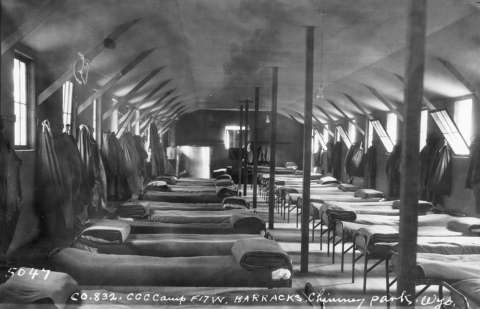
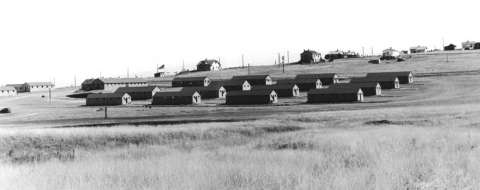
Meanwhile, Camp BR-10 built the Guernsey State Park Castle and a latrine/outhouse called the "Million Dollar Biffy." The CCC put up the latter for only $6,000; park officials have estimated it would cost $1 million today to be rebuilt. The park's Castle is a two-room picnic shelter that has enormous log supports, limestone rock walls and a massive fireplace.
The daily routine
BR-10 was operated as a strict military camp, while BR-9 was overseen by a U.S. Bureau of Reclamation superintendent, James Coffman. The work crews at both camps were divided into engineering, agricultural and landscaping units.
The schedule was the same for both—reveille at 6 a.m. sharp and breakfast precisely an hour later. A typical breakfast included bacon or ham, fruit, eggs and cereal.
Lunch was brought to crews working in the field unless they were close enough to walk to camp. The menu for supper was a large portion of roast beef, pork or chicken, potatoes and gravy, vegetables and fruit, bread, butter and jellies.
The men were required to be clean and presentable at all times, which meant clean and combed hair, brushed teeth and a shower at least once a week.
From 7:30 to 9 p.m., men could shop at the post exchange or play cards at the canteen. The recreation center had two pool tables and a pingpong table. The "lights out" order was given promptly at 10 p.m.
Friday night was reserved for entertainment, including talent shows, singing and dancing. Boxing and wrestling matches were also held. People from the local town often came to entertainment night, both as performers and just to see the show.
Guernsey State Park had a nine-hole public golf course built by the CCC, but there is no evidence that the men ever spent any time playing golf. The course was abandoned in the early 1940s.
On weekends the men at Wyoming CCC camps played pick-up baseball, often against local teams or teams from other camps. Hiking, climbing, horseshoes and basketball on dirt courts were also popular, as were trips to town where sometimes the CCC members were not on their best behavior, especially if the town had a red-light district or ignored Prohibition, still at least nominally in effect in 1933.
Kimmett recalled that after the June 1933 payday, a half-dozen boys at his Yellowstone camp spent the weekend in Gardiner, Mont. "Returning to camp early Monday morning, about three or four of the boys were rolling in their vomit on the floor of the stake truck," he wrote. "These unfortunates learned the hard way about the prevalent falsehood that rubbing alcohol became harmless when filtered through a slice of bread."
The CCC's final days
Roosevelt wanted to make the CCC permanent, but Congress wouldn't go along with him. When World War II started, lawmakers realized it needed the members of the Corps to enter the military. Congress never actually abolished the CCC, but it quit funding the program. On July 1, 1942, it approved $8 million to liquidate it.
The primary impact of the program on the state and nation was three-fold. First, its $25 per month benefit for members' families is credited with helping to jump-start the Depression economy when a spark was desperately needed. The CCC put more than 2.5 million men and 8,000 women to work nationwide.
Second, Wyoming has many one-of-a-kind structures such as the classic Guernsey State Park Museum that remain well used and popular. The CCC crews also greatly expanded the state's infrastructure. In the Bighorn National Forest alone, workers helped build Sibley and Meadowlark Dams, developed 102 acres of campground, built three fire towers, constructed 25 bridges and strung 88 miles of telephone line.
The CCC provided substantial economic help to the families in towns near the camps. Local workers who had lost their jobs were hired to build many of the larger facilities and structures at the camps. By preserving valuable timber resources, the CCC also helped keep alive the industries that communities depended upon.
An intangible but vital benefit of the CCC was the positive impact the program had on those who served. It helped thousands of young men learn construction and wildlife preservation skills, gave them an opportunity to continue their formal education and even transformed their appearance and attitude. The program changed their lives and helped make them better citizens when they returned home.
In September 1933, a convoy of CCC men was taken by truck to meet a train headed out of the park at West Yellowstone. Decades later, Denver Post columnist Red Fenwick recalled that the crews he supervised were no longer the rag-tag, insubordinate troops who began working that spring. "Uniforms were neat. Neckties were tied. There was order and discipline," he recalled. "And the men themselves were tougher, browner, heavier, more self-assured, confident and cooperative."
Resources
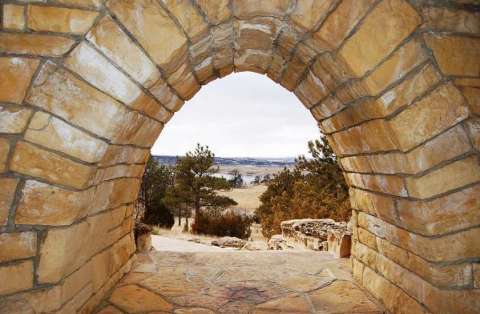
Some of the sandstone for the CCC buildings at Guernsey State Park was quarried near Thermopolis, Wyo., 250 miles away. Here, an archway of The Castle frames the park and Guernsey Reservoir beyond it. Venice Beske, Wyoming Places. Cassity, Mike. "Building Up Wyoming, Depression-Era Federal Projects in Wyoming, 1929–1943." Wyoming State Historic Preservation Office. 2013, 68-76. Accessed March 1, 2016, at http://wyoshpo.state.wy.us/pdf/BuildingUpWyoming.pdf.
- Fenwick, Red. "The Civilian Conservation Corps: They Took to the Woods--and Came Out Men." The Denver Post, Empire section, June 20, 1965.
- Kimmett, Leo. "Life in a Yellowstone Camp." Annals of Wyoming, 56 no. 1: (Spring 1984), 12-21. Accessed Feb. 17, 2016, at https://archive.org/stream/annalsofwyom56121984wyom#page/n13/mode/2up.
- Noble, Ann. "Civilian Conservation Corp." Accessed Feb. 17, 2016, at
- http://www.sublette.com/history/ccc/.
- Waring, Neil A. "Civilian Conservation Corps and the Building of Guernsey State Park: With Folktales and Stories of the Park," Guernsey, Wyo.: Old Trails Publishing, 2015.
- Wikipedia. https://en.wikipedia.or/wiki/Category:Civilian_Conservation_Corps_in_Wyoming. Accessed July 25, 2016.
Illustrations
- The photos of the young CCC men playing craps and sitting on a bench with Vlasta Fisher are from the Lora Nichols Collection at the Grand Encampment Museum. Used with permission and thanks.
- The photo of The Castle at Guernsey State Park was originally published at WyomingHeritage.org, a former project of the University of Wyoming Anthropology Department and the state of Wyoming. The photo of the park looking through an archway of The Castle is by Venice Beske, from Wyoming Places. Both are used with permission and thanks.
- The rest of the photos are from Wyoming State Archives. Used with permission and thanks.
